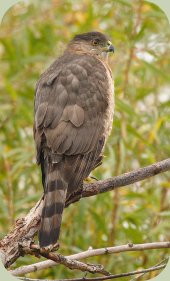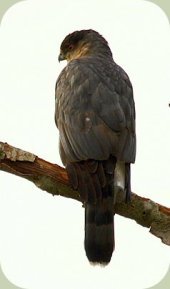Sharp-shinned Hawk and Coopers Hawk
Agile Aerial Acrobats

The sharp-shinned hawk and Coopers hawk are a common and exciting part of the ecology of many suburban parks, woodlands, and neighborhoods. These two members of the family known as Accipitridae, are built for speed and maneuverability. Like all members of their family, they are characterized by their short wings and long tail. Both hawks live mainly on a diet of birds. Though the two types of hawks are often confused, there are some definite differences.
Telling the Sharp-Shinned Hawk and Coopers Hawk Apart
These two hawks can be confusingly similar in physical appearance, so here are some ways to tell them apart:
Sharp-shinned hawk (Accipiter striatus)
- This hawk is the smaller of the two, generally around the size of a jay.
- Body length: Male= 10-12", Female=12-14"
- Wingspan: Male= 20-24", Female= 24-28"
- In typical flight, tail appears squared off and not rounded. Head appears small. Close-up, the eyes look very round and kind of "bug-eyed."
Coopers hawk (Accipiter cooperii)
- This hawk is larger, generally closer to an American crow in size.
- Body length: Male= 15-17", Female= 17-19"
- Wingspan: Male= 27-32", Female= 32-37"
- In typical flight, tail appears rounded off at the end. Head appears large. Close-up, the eyes look stern and have a thin, yellowish ridge sticking out slightly over them.

Natural History
As you may have noticed from the measurements above: the female of both types of hawks are larger than the males. This is true for most birds of prey throughout the world. Some ornithologists believe that this size difference is an adaptation which minimizes competition between the sexes, allowing the female birds to hunt prey that is too large to tackle for the male hawks.
Sharp-shinned hawks hunt mainly small to medium sized songbirds. Meanwhile, Coopers hawks hunt medium songbirds and birds up to the size of grouse or small ducks. Coopers hawks also hunt some small mammal prey such as rats, chipmunks and squirrels.
Both hawks are very fast in level flight, and often catch birds in mid-flight with a swift grab from their sharp talons. Incredibly, these hawks can fly at nearly full speed through dense woodlands and squeeze through gaps not much larger than their body width without even breaking stride!
Be More Prepared For Your Next Outdoor Adventure!

Don't leave home without knowing these six essential survival skills. Our free survival mini guide reveals the strategies of:
- Shelter & fire to prevent the number one cause of death
- Obtaining clean water to avoid life-threatening dehydration
- Common wild survival foods and other critical skills!

Both of these species help keep birds populations healthy by taking out those who are unhealthy or unwary. Although some bird watchers express great frustration at observing these birds of prey hunting the songbirds that visit their feeders, it is important to remember that they help keep the feeder a healthier place for the birds to eat. Over-crowding at bird feeders and feeding stations can cause a variety of problems, including helping spread disease between and among species of songbirds.
If you are lucky enough to witness these hawks flying around in your area, enjoy watching some of the best aerial hunters in the world!
By the way, when you're out birding, it's important to know how to stay safe in the outdoors, especially if you were to get lost. Right now you can get a free copy of our mini survival guide here, where you'll discover six key strategies for outdoor emergencies, plus often-overlooked survival tips.

Resources:
Check out this helpful guide from FeederWatch.org
Learn about Alderleaf's Courses!

About the Author: Filip Tkaczyk is a periodic guest teacher at Alderleaf. He also wrote the field guide Tracks & Sign of Reptiles & Amphibians. Learn more about Filip Tkaczyk.
Return from Sharp-shinned Hawk & Coopers Hawk back to Bird Articles
Is The Essential Wilderness Survival Skills Course Right for You? Take the "Online Survival Training Readiness" Quiz
See for yourself if this eye-opening course is a good fit for you. It takes just a few minutes! Get your Survival Training Readiness Score Now!

Grow Your Outdoor Skills! Get monthly updates on new wilderness skills, upcoming courses, and special opportunities. Join the free Alderleaf eNews and as a welcome gift you'll get a copy of our Mini Survival Guide.

 The Six Keys to Survival: Get a free copy of our survival mini-guide and monthly tips!
The Six Keys to Survival: Get a free copy of our survival mini-guide and monthly tips!
Learn more